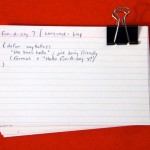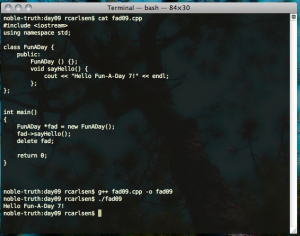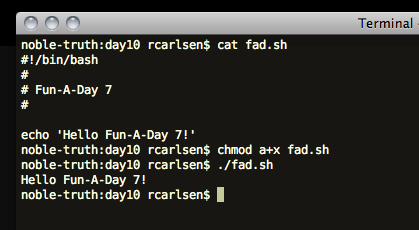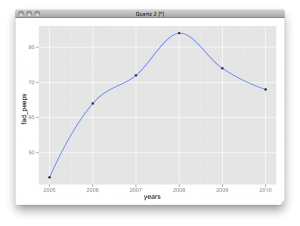 For this year’s Philadelphia Fun-A-Day project I decided to write “Hello World” programs. “Hello World” is a traditional programming tradition where a programmer encountering a new language writes a trivial program which displays the phrase “Hello World”.
For this year’s Philadelphia Fun-A-Day project I decided to write “Hello World” programs. “Hello World” is a traditional programming tradition where a programmer encountering a new language writes a trivial program which displays the phrase “Hello World”.
This introduces the programmer to the basic syntax of the language and demonstrates that their development environment is set up properly to work with that language.
Much of our current environment runs on software, which is generally invisible to us, except when a failure impacts our lives. However, software generally starts as human-readable written text, albeit in a highly defined form using specific vocabulary.
This project attempts to make software visible, in at least a trivial way. The words and structure may differ between languages, but each program is a series of instructions to achieve some end – here to issue a friendly “Hello Fun-A-Day 7!”. Hopefully this can serve to demystify software to some degree, and remind us that software, at some point, has been written by a person.
 The programs here demonstrate a Fun-A-Day variant on Hello World in several languages. I made an effort to explore historical and modern languages, compiled and interpreted languages, console and graphical programs, but avoided esoteric languages which are often difficult to understand by design.
The programs here demonstrate a Fun-A-Day variant on Hello World in several languages. I made an effort to explore historical and modern languages, compiled and interpreted languages, console and graphical programs, but avoided esoteric languages which are often difficult to understand by design.
The Association for Computing Machinery has a collection of Hello World programs:
http://www2.latech.edu/~acm/HelloWorld.html
(Note: I’m generally referring to high-level languages, not considering assembly or binary code. If you’ve read this far, and understand what I mean, then you’ll forgive this simplification made for clarity of purpose)
Language: C
#include <stdio.h>
int main(int argc, char* argv)
{
printf("hello fun-a-day 7! \n");
return 0;
}
Language: JavaScript
// Use Rhino intrepreter to run in a shell
// http://www.mozilla.org/rhino/download.html
function sayHello() {
print('Hello Fun-A-Day 7!');
};
sayHello();
Language: Arduino / Wiring (C++)
#include "WProgram.h"
// prototypes
void blink(int n, int d);
#define unit 100
void dot(int n);
void dash(int n);
void gap();
void pause();
void space();
// variables
int ledPin = 13; // LED connected to digital pin 13
void setup(){
Serial.begin(9600); // opens serial port, sets data rate to 9600 bps
pinMode(ledPin, OUTPUT); // sets the digital pin as output
// print a friendly message to the serial console:
Serial.println("-------------------");
Serial.println(" Hello Fun-A-Day 7");
Serial.println("-------------------");
}
void loop(){
// display "Hello Fun A Day 7" in morse code:
dot(4); pause(); // H
dot(1); pause(); // E
dot(1); dash(1); dot(2); pause(); // L
dot(1); dash(1); dot(2); pause(); // L
dash(3); // O
space();
dot(2); dash(1); dot(1); pause(); // F
dot(2); dash(1); pause(); // U
dash(1); dot(1); // N
space();
dot(1); dash(1); // A
space();
dash(1); dot(2); pause(); // D
dot(1); dash(1); pause(); // A
dash(1); dot(1); dash(2); // Y
space();
dash(2); dot(3); // 7
space();
dot(3); dash(1); dot(1); dash(1); // end-of-message
space();space();space();
space();space();space();
}
void blink(int n, int d){
for (int i=0;i<n;i++)
{
digitalWrite(ledPin, HIGH);
delay(d);
digitalWrite(ledPin, LOW);
delay(unit);
}
}
// timing as specified by International Morse Code
void dot(int n) {
blink(n, unit);
}
void dash(int n) {
blink(n,3*unit);
}
void gap() {
delay(unit);
}
void pause() {
delay(3*unit);
}
void space() {
delay(7*unit);
}
int main(void)
{
init();
setup();
for (;;)
loop();
return 0;
}
Language: Perl
# Fun-A-Day 7
# Perl
#
sub sayHello {
printf("Hello Fun-A-Day 7!\n");
}
sayHello;
Language: Cobol
IDENTIFICATION DIVISION.
PROGRAM-ID. HELLO-WORLD.
PROCEDURE DIVISION.
DISPLAY 'Hello Fun-A-Day 7!'.
STOP RUN.
Language: BASIC
10 print "Hello Fun-A-Day 7!" 20 goto 10
Language: C++
#include <iostream>
using namespace std;
class FunADay {
public:
FunADay () {};
void sayHello() {
cout << "Hello Fun-A-Day 7!" << endl;
};
};
int main()
{
FunADay *fad = new FunADay();
fad->sayHello();
delete fad;
return 0;
}
Language: bash
#!/bin/bash # # Fun-A-Day 7 # echo 'Hello Fun-A-Day 7!'
Language: Processing
// Fun-A-Day 7
// Processing example
void setup()
{
// initialize the canvas and set some paramaters
size(100,100);
smooth();
noStroke();
}
void draw()
{
// partially "erase" the previous screen
// by drawing a semi-transparent, black rectangle on top
fill(0,55);
rect(0,0,width,height);
// draw another ellipse
fill(204);
float x = random(width); float y = random(height);
ellipseMode(CENTER);
ellipse(x,y,20,20);
// be friendly
sayHello();
}
void sayHello()
{
println("Hello Fun-A-Day 7!");
}
Language: Python
# Fun-A-Day 7
# python example
#
# be sure to mind your indentation!
def sayHello():
print "Hello Fun-A-Day 7!"
sayHello()
Language: Ruby
class FunADay
def sayHello()
print "Hello Fun-A-Day 7!"
print "\n"
end
end
fad = FunADay.new
fad.sayHello
Language: Java
package net.robertcarlsen;
public class FunADay {
public static void sayHello()
{
System.out.println("Hello Fun-A-Day 7!");
}
public static void main(String[] args) {
sayHello();
}
}
Language: C#
/* Fun-A-Day 7
*
* C#
*/
class HelloFunADay
{
static void Main () {
System.Console.Write("Hello Fun-A-Day 7!\n");
}
}
Language: sed (bash)
#!/bin/bash # This is just a simple example of using sed # for find and replace. # echo will just spit out the quoted text # '|' is the pipe operator, and sends the output from # echo to the next program, in this case sed # sed is using the 's'earch operation # 's/find stuff here/replace it here/' # the parentheses match stuff that we can refer to later as \1 # .* means match any character, zero or more repeated times # but it won't include the literal phrase " World" because that's # specifically written in the match expression. echo "Hello World" | sed 's/\(.*\) World/\1 Fun-A-Day 7!/'
Language: Lisp
;;; Fun-A-Day 7 ;;; Robert Carlsen ;;; ;;; Lisp version (defun sayhello () "the basic hello" ; make sure to be friendly (format t "Hello Fun-A-Day 7!") )
Language: php
<?php
printf("Hello Fun-A-Day 7! \n");
?>
Language: Go
package main
import "fmt"
func main() {
fmt.Println("Hello, Fun-A-Day 7!")
}
Language: Objective-C / Cocoa
(There is far too much boilerplate code and dependent project files to paste here, but this is the bit which drives some simple interaction – displaying an alert if you tap the badger image several times)
@interface Fun_a_Day7ViewController : UIViewController {
}
@property(nonatomic,retain)IBOutlet UILabel *badgerLabel;
- (IBAction)badger:(id)sender;
@end
@implementation Fun_a_Day7ViewController
@synthesize badgerLabel;
static int count = 0;
- (IBAction)badger:(id)sender;
{
self.badgerLabel.hidden = !self.badgerLabel.hidden;
if(++count > 4) {
UIAlertView *alert = [[UIAlertView alloc] initWithTitle:@"Badger"
message:@"No, seriously...quit badgering me!"
delegate:nil
cancelButtonTitle:@"Stop it"
otherButtonTitles:nil];
[alert show];
[alert release];
count = 1;
}
}
@end
Language: R
# Fun-a-day 7 # R language for statistical computing # fad_peeps <- c(43,64,72,84,74,68) years <- seq(2010-5,2010) data.frame(years,fad_peeps) -> fadData fadData # years fad_peeps #1 2005 43 #2 2006 64 #3 2007 72 #4 2008 84 #5 2009 74 #6 2010 68 require(ggplot2) qplot(years,fad_peeps,fadData) + geom_smooth()






Leave a Reply
You must be logged in to post a comment.